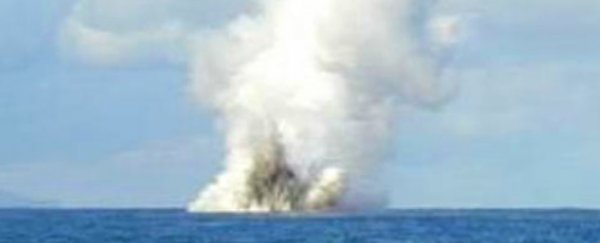For a fiery phenomenon we most commonly associate with magma-spewing mountaintops, it's easy to forget that some 70 percent of all Earth's volcanism takes place under the ocean waves.
That statistic is a problem for scientists eager to learn more about underwater volcanoes, which, due to their submarine environment, are difficult to study.
New research shows a clever workaround, though – as well as revealing an incredible side effect of intense magma eruptions at the bottom of the sea.
In a new study, a team led by geophysicist John Lyons from the US Geological Survey's Alaska Volcano Observatory analysed recordings of low-frequency sound in the atmosphere (called infrasound) produced by over 70 explosive eruptions that took place at the underwater Bogoslof volcano off the coast of Alaska between 2016 and 2017.
Due to its remote location, Bogoslof is rarely witnessed when it erupts, but historical accounts tell vivid tales of what it looks like when a submerged volcano lets loose.
An eyewitness account observed from the steamer Albatross in 1908 describes a "colossal soap bubble" rising out of the ocean, with "gigantic clouds of smoke and steam", while another reports a "gigantic dome-like swelling" of water "as large as the dome of the capital at Washington … like a huge bubble pushing its way through the water".
Thanks to Lyon and his team, we now have a scientific explanation for these mysterious historical descriptions of Bogoslof's colossal dome-like gas bubbles.
 The evolution of a 'hydrovulcanian' explosion. (Lyons et al., Nature Geoscience, 2019)
The evolution of a 'hydrovulcanian' explosion. (Lyons et al., Nature Geoscience, 2019)
Analysing the infrasound recordings of Bogoslof's 2016–2017 eruptions – sound waves lower in frequency than human ears can hear – the researchers came up with a model for the probable source mechanism of the volcano's deep rumbles.
"The infrasound originates from the oscillation and rupture of magmatic gas bubbles that initially formed from submerged vents, but that grew and burst above sea level," the authors explain in their paper.
"We model the low-frequency signals as over-pressurised gas bubbles that grow near the water–air interface, which require bubble radii of 50–220 metres."
If the researchers are right in their calculations, these noxious, gassy volcano bubbles could extend up to 440 metres (over 1,400 ft) in diameter.
That would make them about the height of Malaysia's Petronas Towers (the tallest buildings in the world until 2004), yielding an immense bubble volume that could easily swallow multiple Great Pyramids of Giza.
Quite the spectacle to see rising ominously out of the ocean – even before it inevitably bursts.
"Imagine the violence of a normal volcanic eruption, but then you add a bunch of water to it," Lyons told Wired.
Pretty crazy stuff, adding to the list of really weird geophysical by-products that we already know about when it comes to underwater volcano eruptions, from vast fields of volcanic glass, to floating pumice rafts, plus fleeting pop-up islands, and the speedy ecosystems they seem to enable.
The findings are reported in Nature Geoscience.
